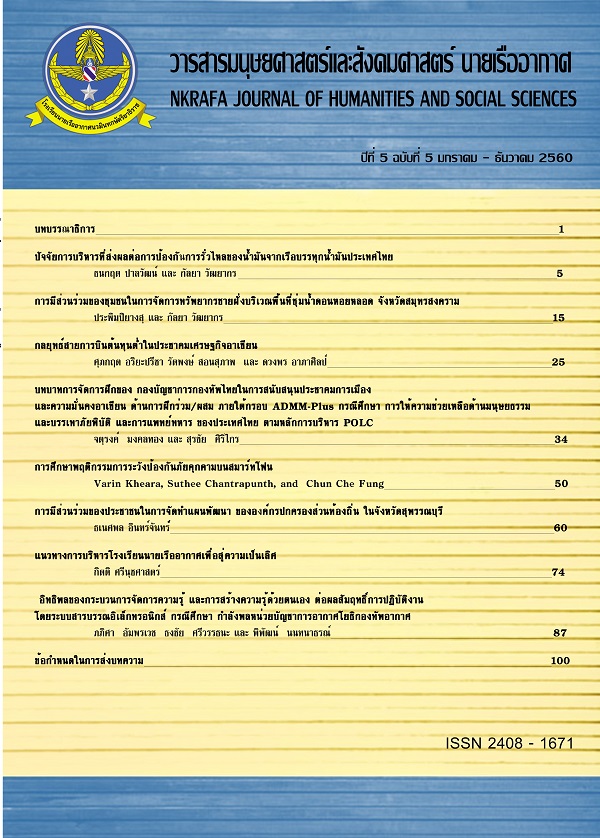Training Management Roles of the Royal Thai Armed Force Headquarters in Supporting the ASEAN Political-Security Community of the Joint and Combined Military Exercise Under the Framework of the ASEAN Defence Ministers’ Meeting-Plus (ADMM-Plus)
Main Article Content
Abstract
The objectives of this research were to 1) study the joint and combined military exercise under the framework of the ASEAN Defence Ministers’ Meeting-Plus (ADMM-Plus) : a case study of Humanitarian Assistance and Disaster Relief (HADR) and Military Medicine (MM) of Thailand in regard to 1) the training management roles of the Royal Thai Armed Force Headquarter; 2) the administrative principle of the POLC affecting the training management roles of the Royal Thai Armed Force Headquarter; 3) the obstacle of the training management roles of the Royal Thai Armed Force Headquarters; 4) propose development approach for the training management roles of the Royal Thai Armed Force Headquarter by focusing on mixed research for both quantitative and qualitative researches. The populations used in the study were limited amount under Ministry of Defence, Royal Thai Armed Force Headquarters, Royal Thai Army Medical Department and Royal Thai Air Force Medical Department which divided to 240 persons for quantitative research and 18 persons from aforementioned government agencies (except Royal Thai Air Force Medical Department) who gave important information for qualitative research.
The results of quantitative research upon considering the relationship between the four variables of Administrative Principle of POLC consisting of 1) Planning : P, 2) Organizing : O, 3) Leading : L, 4) Controlling : C, and Joint and combined training management roles revealed that Planning: P/emphasis of strategic management was the highest positively related to the joint and combined training management roles. The results of qualitative research could be concluded as follows: the obstacle that affected the training management roles of the Royal Thai Armed Force Headquarter was the lack of unity in implementation due to the identity of state agency. The findings also revealed that another factor that affected the training management roles of the Royal Thai Armed Force Headquarters was Coordinating : C, this indicated that the coordinating was one of the important factor to affect the organization success or failure in operation. Therefore, the researcher wished to propose the Model of an additional management principle from POLC to be POLCC which consists of 1) Planning : P, 2) Organizing : O, 3) Leading : L, 4) Coordinating : C and 5) Controlling : C, so that the training management of the Royal Thai Armed Force Headquarters will be higher efficient.
Article Details
บทความที่ได้รับการตีพิมพ์เป็นลิขสิทธิ์ของวารสารมนุษยศาสตร์และสังคมศาสตร์ นายเรืออากาศ
ข้อความที่ปรากฎในบทความแต่ละเรื่องในวารสารวิชาการเล่มนี้ เป็นความคิดเห็นส่วนตัวของผู้เขียนแต่ละท่าน ไม่เกี่ยวข้องกับโรงเรียนนายเรืออากาศฯ และคณาจารย์ท่านอื่น ๆในโรงเรียนนายเรืออากาศฯ แต่อย่างใด ความรับผิดชอบขององค์ประกอบทั้งหมดของบทความแต่ละเรื่องเป็นของผู้เขียนแต่ละท่าน หากมีความผิดพลาดใด ๆ ผู้เขียนแต่ละท่านจะรับผิดชอบบทความของตนเองแต่เพียงผู้เดียว
References
[2] คณาจารย์สาขาวิชาการจัดการ คณะบริหารธุรกิจ มหาวิทยาลัยเทคโนโลยีราชมงคลธัญบุรี. (2556). หลักการจัดการและองค์การ. กรุงเทพมหานคร: ทริปเพิ้ล เอ็ดดูเคชั่น จำกัด.
[3] รังสรรค์ ประเสริฐศรี. (2549). การจัดการสมัยใหม่ (Modern Management). กรุงเทพมหานคร: บริษัท ธรรมสาร จำกัด. (2551). ภาวะผู้นำ (Leadership). (พิมพ์ครั้งที่ 2). กรุงเทพมหานคร:บริษัท ธีระฟิลม์ และไซเท็กซ์ จำกัด.
[4] วรเดช จันทรศร. (2551). ทฤษฎีการนำนโยบายสาธารณะไปปฏิบัติ, (พิมพ์ครั้งที่ 3). กรุงเทพฯ:พริกหวานกราฟฟิก.
[5] วิฑูรย์ ศิริปักมานนท์. (2555). สมรรถนะหลักของทหารไทยในการเข้าสู่ประชาคมอาเซียนของนักศึกษาวิทยาลัยป้องกันราชอาณาจักร หลักสูตรการป้องกันราชอาณาจักร รุ่นที่ 57 วิทยาลัยป้องกันราชอาณาจักร. กรุงเทพมหานคร.
[6] วัลลภ รักเสนาะ. (2555). แนวทางการพัฒนาให้กองทัพไทยเป็นหนึ่งเดียว ของนักศึกษาวิทยาลัยป้องกันราชอาณาจักร หลักสูตรการป้องกันราชอาณาจักร รุ่นที่ 54 วิทยาลัยป้องกันราชอาณาจักร.กรุงเทพมหานคร.
[7] สถาบันดำรงราชานุภาพ สำนักงานปรับกระทรวงมหาดไทย. (2553). เทคนิคการประสานงาน.ค้นเมื่อ กันยายน 11,2560, https://www.stabundamrong.go.th
[8] สำนักเลขาธิการคณะรัฐมนตรี. (2556).รายงานผลการจัดการฝึกซ้อมการบรรเทาภัยพิบัติ ARF DiREx 2013. ค้นเมื่อ กุมภาพันธ์ 22,2560, https://www.cabinet,soc.go.th
[9] Allport, Gordon (1937). Personality : A. Psychological Interpretation. New York : Holt.
[10] Dess, Gregory G. and Miller, Alex. (1993). Strategic Management. Singapore: McGraw-Hill.
[11] Hill, Chatles W. L. and Jonesand, Gareth R. (2009). Strategic Management Theory : An Integrated Approach. South-Western : Cengage Learning.
[12] Hogwood, Brian W. & Gunn, Lewis A. (1984). Policy Analysis for the Real World. New York: Oxford University Press.
[13] Malcom Baldrige National Quality Award. (2009). 2009-2010 Education criteria for Performance Excellence. Baldrige national quality program.
[14] Morgan, Gareth. (1997). Images of Organization (2nd ed.). California: Sage.
[15] Oke, Adegoke.,Munshi, Natasha. & Walumbwa, Fred O. (2009). “The Influence of Leadership on Innovation Processes and Activities,” Organizational Dynamics
[16] Robbins, Stephen P. & Coulter, M. (2012). Management. New Jersey : Prentice Hall.
[17] Robbins, Stephen P; & Judge, Timothy A. (2007). Organizational Behavior. 12th ed. New Jersey: Pearson Prentice-Hall.
[18] Schermerhorn, John R., James G. Hunt and Richard N. Osborn. Organizational Behavior. 8th ed. USA. : John Wiley & Sons, lnc., 2002.
[19] Stufflebeam, Daniel L. (2001). “ The Meta - Evaluation Imperative. ” American Journal of Evaluation.


